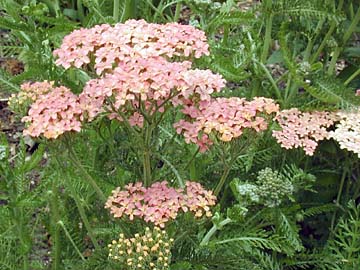|
An ounce of preventionby AMY STEWART SO IT'S ONLY MARCH, AND ALREADY
I'M TIRED. FOR some reason, as I start to work on this year's
garden, I keep thinking back to last September, when everything
was spiraling out of control. The squash went wild. The hollyhocks
reached an astonishing 10 feet and leaned precariously across
paths, or in whatever direction made them most in the way. Aphids
held family reunions on my rose bushes. The berry vines became
infested with some spotty and sinister disease. And the weeds?
Bindweed and blackberry covered everything. [Yarrow photo by Grace Kerr] Sometimes a garden can be a bit much. There are days when my garden seems less like an oasis, a refuge, and more like a set of problems to solve. Maybe that's why I'm thinking less about planting and more about preventing this spring: preventing diseases, keeping pests out, and taking a stand against the weeds now, before they take over. Here are a few ideas for getting the upper hand now: Clean up. You may have had perfectly good reasons for leaving last year's dead annuals in the ground, not pruning the shrubs and leaving groundcovers shaggy and unkempt. Maybe you were creating a habitat for birds; maybe you were worried about frost and thought it best to leave everything alone until winter was past. But there's no more time for excuses. Get out there with the pruning shears and whip everything into shape. Shear back any flowering plant that still has last year's blooms on it. Yank out last year's annuals and toss them on the compost pile. Give low-growing plants like catmint and oregano a much-needed haircut. It's time for the plants in the garden to put out new growth, and they need a little breathing room to get going. Attack weeds. Those baby dandelion seedlings are so cute when they're young, aren't they? Don't be fooled. Get them now. If you start pulling weeds this early in the season, you just might stand a chance against them. Deal with your dirt. Keep a good thick layer of aged compost, shredded bark, or dried leaves on the soil. You'll smother weeds and help suppress diseases that are caused by soil-dwelling bacteria or fungi. Tomatoes are particularly vulnerable to soil-borne disease, so start getting vegetable beds ready now by piling on the mulch and installing a drip irrigation system. Using a drip system for disease-prone plants allows you to avoid overhead watering, which keeps the plant dry and less susceptible to mildew and other diseases that flourish in damp areas. Also, since you won't be watering with a hose, you won't splash soil onto the plant, which can also spread tiny microbes and spores that harbor disease. Bring on the bugs. Keeping pests like aphids and whitefly out of the garden is not so much about waging war on the bug population. In fact, it's mostly about attracting more bugs to the garden. A diverse insect population will keep pests in check naturally. Add lots of small-flowered plants like alyssum, catmint, yarrow and feverfew to the garden. Tiny clusters of flowers attract ladybugs, small beneficial wasps and other creatures that snack on garden pests. This time of year, the ladybugs start trolling the garden for lunch. Look for tiny yellow eggs clustered on the underside of leaves; this is a good sign that ladybugs are laying eggs and setting up camp near the bad guys. If predatory insects don't seem to be doing the job, a strong blast of water from the hose will wash aphids and whitefly away. Try a foliar spray. Liquid organic fertilizers are gaining popularity as a way to get plants the nutrients they need and help prevent disease. The goal is to help the plant reach a healthy size so that it can withstand a little damage from pests or disease and even outgrow an infestation. Fish emulsion and sea kelp are two popular ingredients for liquid fertilizers; just follow the directions on the package, mix up a batch and spray it directly on the plant so that it can absorb the nutrients through the leaves. You can even make your own liquid fertilizer by mixing a small amount of worm castings or compost into a bucket of water, stirring often to aerate the mixture, and then using the liquid immediately while the beneficial microbes from the compost are still suspended in the water. Marshall your resources. Finally, don't forget that our local nurseries are a great resource for identifying plant problems and nipping them in the bud. If you're worried about an insect or a disease in your garden, clip some leaves, drop them in a sealed plastic bag (the nursery staff does not want to adopt your pests or pathogens) and bring them in for identification. They'll be able to tell you what's wrong and suggest a product or a technique to clear it up. And if they can't do that, they'll at least offer a shoulder to cry on. Isn't gardening fun?
garden-related announcements and news to Amy Stewart.
IN THE NEWS | COVER STORY | EDITORIAL | THE HUM | PREVIEW | CALENDAR
© Copyright 2004, North Coast Journal, Inc. |


